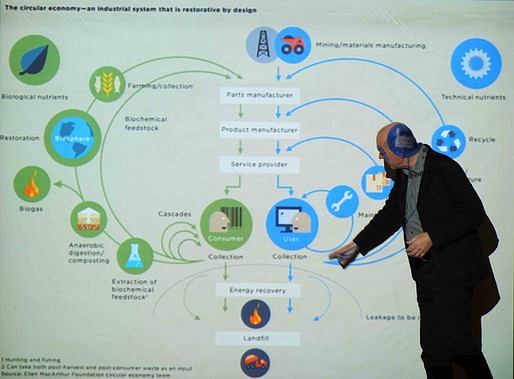
 Ton Venhoeven, the second speaker in the School of Architecture’s lecture series, spoke to us recently about the Sino-Dutch approach to smart cities.
Ton Venhoeven, the second speaker in the School of Architecture’s lecture series, spoke to us recently about the Sino-Dutch approach to smart cities.
 Over the past 40 years urban planning has evolved to focus on sustainable development and reacting to environmental disasters. Although the definition of smart cities is widely debated, the Dutch approach focuses on a few specific goals.
Over the past 40 years urban planning has evolved to focus on sustainable development and reacting to environmental disasters. Although the definition of smart cities is widely debated, the Dutch approach focuses on a few specific goals.
 First, smart cities need to integrate a circular economy where better flow management eliminates waste through features like zero-energy houses, smart cars, and waste recycling systems.
First, smart cities need to integrate a circular economy where better flow management eliminates waste through features like zero-energy houses, smart cars, and waste recycling systems.
 Second, there should be an integration of centralized and decentralized production where buildings generate their own energy, for example. Venhoeven also emphasized the need for clean, integrated transportation where bike shares are linked with subway and light rail lines.
Second, there should be an integration of centralized and decentralized production where buildings generate their own energy, for example. Venhoeven also emphasized the need for clean, integrated transportation where bike shares are linked with subway and light rail lines.

All of these components work to create polycentric, rather than unipolar, cities. Ideally, each pole of the smart city will produce its own energy while fostering independent nodes of office buildings, residences, and recreational areas. Rather than building cities as comprehensive control systems with radial planning expanding from one hub, a smart city takes advantage of open and chaotic networks.


Venhoeven then spoke about the Sino-Dutch approach to smart cities through a case study of Beijing’s Fengtai district.

There were three main goals in redeveloping Fengtai including 1) solving environmental issues, 2) establishing a creative fashion district, and 3) increasing mobility withinthe neighborhood.
 On the environmental front, planners made an effort to institute a circular system for water collection and reuse, increase the amount of green space, and utilize nearby bodies of water like the Yongding River in combatting water shortages.
On the environmental front, planners made an effort to institute a circular system for water collection and reuse, increase the amount of green space, and utilize nearby bodies of water like the Yongding River in combatting water shortages.
 On the culture side, planners placed an emphasis on expanding the value chain in fashion—rather than promoting solely high-end stores, they encouraged the use of space by wholesalers and designers. Developers also sought to promote river-centered leisure and more creative residential areas.
On the culture side, planners placed an emphasis on expanding the value chain in fashion—rather than promoting solely high-end stores, they encouraged the use of space by wholesalers and designers. Developers also sought to promote river-centered leisure and more creative residential areas.
 Finally, Fengtai was connected very well to the city, but intra-neighborhood connectivity was lacking. A new Fengtai station would link one side of the district to the other, which would also help ease the flow of traffic.
Finally, Fengtai was connected very well to the city, but intra-neighborhood connectivity was lacking. A new Fengtai station would link one side of the district to the other, which would also help ease the flow of traffic.
In Fengtai and regarding the Sino-Dutch approach to smart cities generally, it is important to emphasize people-centered planning, where the goal of any initiative is to improve the quality of life. The Dutch approach seems to best exemplify this people-centered focus, from Venhoeven’s talk, particularly as Venhoeven emphasized the idea that urban planning does not work around issues of life in the city, but has tremendous potential to solve these issues. The question for us is which direction China will take in the development of smart cities, and if it will pursue new and radical approaches to urban planning or follow a more traditional, perhaps outdated path.
In the School of Architecture at Tsinghua University, Beijing, the English Program for Master Architecture (EPMA) provides a nationally accredited post-professional program in integrated architectural design. It combines a global network with local implementation. The program is focused on the construction of the human habitat, and the application of advanced building technologies.
No Comments
Block this user
Are you sure you want to block this user and hide all related comments throughout the site?
Archinect
This is your first comment on Archinect. Your comment will be visible once approved.